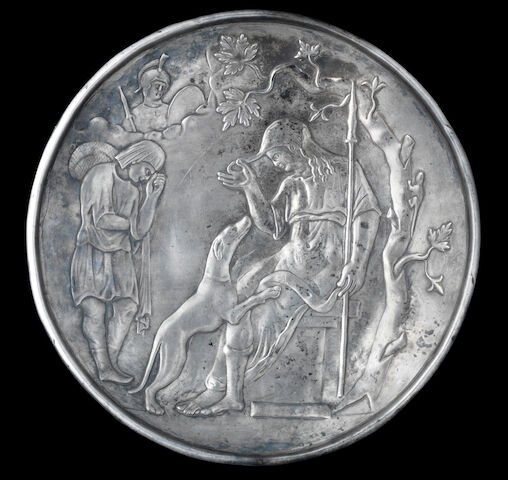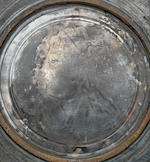Ο βρεττανικός οίκος Bonham's συνεχίζει τις πωλήσεις

ΚΑΙ ΤΟ ΠΑΡΑΚΑΤΩ ΚΕΙΜΕΝΟ ΣΧΕΤΙΚΟ ... silver plate Βυζαντινό του Οδυσσέα και πιθανολογείται ότι είναι από Κωνσταντινούπολη ...



Ο Οδυσσέας καλωσορίζεται στη πατρίδα από τον σκύλο του, τον Άργο, ερχόμενος από τον Τρωικό Πόλεμο ... ΠΩΛΕΙΤΑΙ στις 2 Οκτωβρίου στο Λονδίνο ...
A stunning Byzantine silver plate bearing an illustration of a happy homecoming - Odysseus welcomed home from the Trojan wars by his dog Argus - leads Bonhams sale of Antiquities on 2nd October in London.
The touching reunion scene of the hero and his faithful hound is beautifully worked into this silver Byzantine plate which is estimated to sell for £200,000 to £250,000. It is believed to date from around the mid-6th to mid-7th Century A.D. and possibly originates from Constantinople. It measures 9¼in (23.5cm) diam; 865g weight.
Odysseus, the great eponymous hero of Homer's epic poem The Odyssey was the king of Ithaca and the plate depicts the end of his ten-year journey home from the Trojan Wars. Homer tells us that at the goddess Athena's suggestion, Odysseus disguises himself as a beggar to ascertain the loyalty of his household. This plate captures the moment that Odysseus, accompanied by the servant Eumaeus, is recognized by his dog Argus despite his master's disguise of the long unkempt hair of a beggar. The goddess Athena looks on to watch the culmination of her protection of Odysseus.
The shallow dish is double-skinned with a rounded rim and a short circular foot. The interior has a finely incised and chased relief scene which has been identified as depicting Odysseus dressed as a beggar greeting Argus the dog on his arrival home. The hero is shown seated in front of a tree wearing long drapery with sandals tied at his calves, holding a spear in his left hand, and holding out a lock of hair between thumb and forefinger of his right hand, his long hair falling to his shoulders.
Argus the dog wears a collar and leaps up with his front paws resting on his master's knees. A servant Eumaeus stands to the left of the scene wearing a short tunic and boots, a sack over his left shoulder. A bust of the goddess Athena emerges from clouds above. The reverse of the plate shows a finely chased profile head of a man, probably Alexander the Great.
This type of impressive luxury silver 'picture dish' has its origins in Roman Imperial silver 'show plates' of the 1st Century A.D. found in a number of hoards from throughout the Roman Empire. Later Roman hoards of luxury silver ware from the 4th and 5th Centuries have contained pagan iconography alongside Christian inscriptions and themes, demonstrating the continuation of traditional mythological subjects well into the Early Christian and Byzantine eras.
NOTES FOR EDITORS
Bonhams, founded in 1793, is one of the world's largest auctioneers of fine art and antiques. The present company was formed by the merger in November 2001 of Bonhams & Brooks and Phillips Son & Neale. In August 2002, the company acquired Butterfields, the principal firm of auctioneers on the West Coast of America. Today, Bonhams offers more sales than any of its rivals, through two major salerooms in London: New Bond Street and Knightsbridge; and a further three in the UK regions and Scotland. Sales are also held in San Francisco, Los Angeles, Carmel, New York and Connecticut in the USA; and Germany, France, Monaco, Hong Kong and Australia. Bonhams has a worldwide network of offices and regional representatives in 25 countries offering sales advice and valuation services in 60 specialist areas. For a full listing of upcoming sales, plus details of Bonhams specialist departments go to www.bonhams.com
ΠΗΓΗ: https://www.bonhams.com/press_release/17499/ΚΑΙ ΤΟ ΠΑΡΑΚΑΤΩ ΚΕΙΜΕΝΟ ΣΧΕΤΙΚΟ ... silver plate Βυζαντινό του Οδυσσέα και πιθανολογείται ότι είναι από Κωνσταντινούπολη ...


A Byzantine silver plate
Circa mid-6th to mid-7th Century A.D.
Possibly from Constantinople, of shallow form, double-skinned with a rounded rim and a short circular foot, the interior with a scene in relief, the details finely incised and chased, possibly depicting Odysseus dressed as a beggar greeting Argus the dog on his arrival home, the hero shown in front of a tree with leaves and a small lizard crawling up the trunk, seated on an altar with his legs crossed wearing long drapery with sandals tied at his calves, a spear in his left hand, holding out a lock of hair between thumb and forefinger of his right hand, his long hair falling to his shoulders, Argus the dog wearing a collar and leaping up with his front paws resting on his master's knees, the servant Eumaeus (or possibly Odysseus's son Telemachus) standing to the left of the scene wearing a short tunic and boots, a sack over his left shoulder, his right arm crossed over his body with his left hand held to his forehead, a bust of Athena emerging from clouds at the top right, wearing a crested helmet and cuirass and holding a spear and shield, the reverse with a chased band of acanthus, the underside of the foot with a finely chased profile head of a man with wavy hair and a diadem, probably depicting Alexander the Great, 9¼in (23.5cm) diam; 865g weight
FOOTNOTES
Provenance:
UK private collection, London, acquired in London on 06 September 1976 and accompanied by a copy of the receipt.
Literature:
These types of impressive luxury silver 'picture dishes' have their origins in Roman Imperial silver 'show plates' of the 1st Century A.D. found in a number of hoards from throughout the Roman Empire. Cf D.E. Strong, Greek and Roman Gold and Silver Plate, Cornell University Press, 1966, p. 150. Later Roman hoards of luxury silver ware from the 4th and 5th Centuries have contained pagan iconography alongside Christian inscriptions and themes, demonstrating the continuation of traditional mythological subjects well into the Early Christian and Byzantine eras.
Such deployment of Classical themes has been interpreted as 'once-potent sacred imagery designed to invoke the fast-vanishing Classical past and the culture of pagan paideia in an already Christian cultural context': J. Elsner, Imperial Rome and Christian Triumph, Oxford, 1998, p. 209. Paideia was a traditional educational programme for the Graeco-Roman elite since the Hellenistic period and its continuity amongst members of the early Byzantine elite is clear in both visual and literary culture of the period. For further discussion, see. R. Leader-Newby, 'Classicism and Paideia in Early Byzantine Silver from the Hermitage', in F. Althaus and M. Sutcliffe, (eds.), The Road to Byzantium: Luxury Arts of Antiquity, London, 2006, pp. 67-73.
Other plates of a similar period in the State Hermitage Museum, St Petersberg depict comparable mythological subjects. For example Meleager and Atalanta setting off for a hunt (inv. no. ω 1) and the quarrel between Ajax and Odysseus over Achilles's armour with Athena presiding (inv. no. ω 279). Cf. Althaus and Sutcliffe, op. cit., p. 159, nos. 86-7.
The subject matter of this lot can certainly be seen in the context of paideia and the study of important works of classical literature. Odysseus, the great eponymous hero of Homer's epic poem The Odyssey was the king of Ithaca and the plate depicts the end of his ten-year journey home from the Trojan Wars. Homer tells us that at the goddess Athena's suggestion, Odysseus disguises himself as a beggar to ascertain the loyalty of his household. This plate captures the moment that Odysseus, accompanied by the servant Eumaeus, is recognised by his dog Argos despite his master's disguise of the long unkempt hair of a beggar. The goddess Athena looks on to watch the culmination of her protection of Odysseus.
Outside of traditional paideia, it is also possible to trace the adoption of classical mythological subjects into Christian writings of late antiquity onwards. Gregory of Nazianzus, the 4th Century A.D. Christian Church Father advocated the study of classical literature and Odysseus appears in his homilies with the hero's wanderings given a Christian symbolic interpretation.
It is possible to date this plate to the mid-6th to mid-7th Century A.D. Similar styles of decoration and mythological subjects have been found on plates dated by control stamps to the reign of the emperor Justinian I (A.D. 526-65). For example a silver plate now in the Hermitage (inv. no. ω 277) shows a related seated figure identified as a goatherd, also with a tree and a dog: R. Cormack & M. Vassilaki (eds.) Byzantium 330-1453, Royal Academy of Arts, London, 2008, pp. 88-9, 386, no. 33. The stylistically close aforementioned Meleager and Atalanta plate can be dated from control stamps to A.D. 613-29: Althaus and Sutcliffe, op. cit., pp. 58-9, no. 87. There is also a silver plate probably from Constantinople, now in the Bayerisches Nationalmuseum in Munich (inv. L.56/113) depicting Meleager wearing very similar boots to Odysseus: L. Wamser, Die Welt von Byzanz - Europas östliches Erbe, Munich, 2004, pp. 244-5, no. 358.
The chased acanthus frieze on the reverse is very close to that on a silver bowl from Constantinople, now in the Hermitage (inv. no. ω 280) also dated to the reign of Justinian: Exhibition Catalogue, Alexander the Great. The Road to the East, The State Hermitage, Saint Petersburg, 2007, p. 356, no. 393. The underside of the foot of this plate is decorated with a chased depiction of a horse as opposed to the profile head, probably of Alexander the Great, on the reverse of the Odysseus plate. The subject and style of this decoration can be seen as very much in accordance with the classicising subject of the main plate.
Other details of the Odysseus plate can also be paralleled in Byzantine art of differing media. For an early 6th Century marble relief fragment from Constantinople, now in Berlin, depicting a servant with very similar headwear and drapery to the youth on the Odysseus plate cf. L. Wamser, Die Welt von Byzanz - Europas östliches Erbe, Munich, 2004, p. 216, no. 314.
ΠΗΓΗ: https://www.bonhams.com/auctions/21928/lot/142/
Δεν υπάρχουν σχόλια:
Δημοσίευση σχολίου
αβαγνον